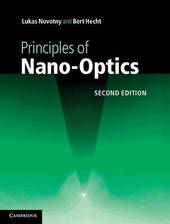
|
Principles of Nano-Optics
Hardback
Main Details
| Title |
Principles of Nano-Optics
|
| Authors and Contributors |
By (author) Lukas Novotny
|
|
By (author) Bert Hecht
|
| Physical Properties |
| Format:Hardback | | Pages:578 | | Dimensions(mm): Height 252,Width 192 |
|
| Category/Genre | Optics
Nanotechnology |
|---|
| ISBN/Barcode |
9781107005464
|
| Classifications | Dewey:535 |
|---|
| Audience | | Professional & Vocational | |
|---|
| Edition |
2nd Revised edition
|
| Illustrations |
Worked examples or Exercises; 5 Tables, black and white; 200 Line drawings, unspecified
|
|
Publishing Details |
| Publisher |
Cambridge University Press
|
| Imprint |
Cambridge University Press
|
| Publication Date |
6 September 2012 |
| Publication Country |
United Kingdom
|
Description
First published in 2006, this book has become the standard reference on nano-optics. Now in its second edition, the text has been thoroughly updated to take into account new developments and research directions. While the overall structure and pedagogical style of the book remain unchanged, all existing chapters have been expanded and a new chapter has been added. Adopting a broad perspective, the authors provide a detailed overview of the theoretical and experimental concepts that are needed to understand and work in nano-optics, across subfields ranging from quantum optics to biophysics. New topics of discussion include: optical antennas; new imaging techniques; Fano interference and strong coupling; reciprocity; metamaterials; and cavity optomechanics. With numerous end-of-chapter problem sets and illustrative material to expand on ideas discussed in the main text, this is an ideal textbook for graduate students entering the field. It is also a valuable reference for researchers and course teachers.
Author Biography
Lukas Novotny is Professor of Optics and Physics at the University of Rochester where he heads the Nano-Optics Research Group at the Institute of Optics. He received his Ph.D. from the Swiss Federal Institute of Technology in Switzerland and later joined the Pacific Northwest National Laboratory (Washington, USA) as a research fellow, working in the Chemical Structure and Dynamics Group. In 1999, he joined the faculty of the Institute of Optics at the University of Rochester and developed a course on nano-optics which has been taught several times at the graduate level and which forms the basis of this textbook. His general interest is in nanoscale light-matter interactions ranging from questions in solid-state physics to biophysics. Bert Hecht is Professor of Experimental Physics at the University of Wurzburg. After studying physics at the University Konstanz, he joined the IBM Zurich Research Laboratory in Ruschlikon and worked in near-field optical microscopy and plasmonics. In 1996 he received his Ph.D. from the University of Basel and then joined the Physical Chemistry Laboratory of the Swiss Federal Institute of Technology where he worked on the combination of single-molecule spectroscopy with scanning probe techniques. In 2001, he was awarded a Swiss National Science Foundation research professorship at the University of Basel. His research interests comprise the enhancement of light-matter interaction on the nanometerscale.
Reviews'The reader will appreciate its scope and depth, as it covers topics ranging from resolution and microscopy to metamaterials and optical antennas. This book provides an integrated approach to the entire field, and the format breaks the material into accessible sub-units. The physical and mathematical rigor is high, and approximations and limitations of the theory and the experimental devices are clearly stated. The material is highly recommended for a graduate course.' Barry R. Masters, Optics and Photonics News 'This text responds to the growing importance of nanoscience, and presents a rare collection of topics across optics and microscopy at the nanoscale. A major goal of nano-optics is to extend the use of optical techniques to length scales beyond the diffraction limit. Notably, the book features a valuable discussion of resolution, localization and position accuracy in microscopy. A non-exhaustive list of subjects covered in later chapters includes near- and far-field microscopy techniques, quantum emitters and surface plasmons in nanostructures.' Lukas Novotny and Bert Hecht, 'All-Time Favourites', Nature Photonics
|